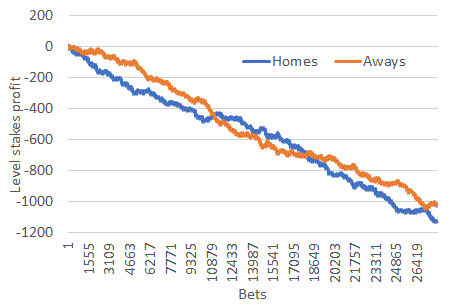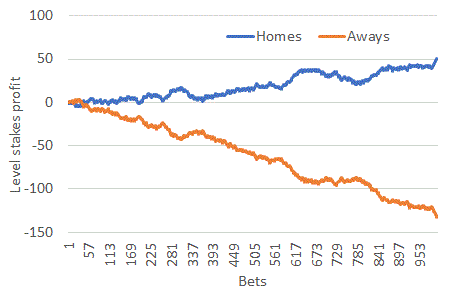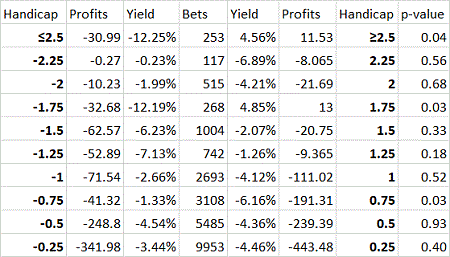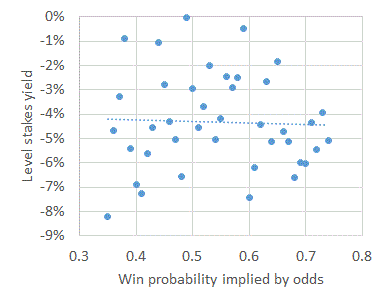Are their any biases in the Football Asian Handicap Market?
Posted 8th February 2019
Over the years I've written a lot of material discussing the favourite-longshot bias in football match betting markets, where the odds bookmakers offer on longshots are shortened by more than we would otherwise expect, relative to favourites. Reasons for this include supply-side (bookmaker) protection against liabilities associated with insider knowledge and demand-side (punter) cognitive biases which predispose punters to the attraction of bigger wins.
In contrast to the over betting of longshots in European fixed odd / moneyline markets, Steven Levitt (famous for the book Freakonomics) reviewed evidence for a potential over betting of point spread favourites in the NFL betting market. One reason why this might happen is 'intuitive confidence.' The more people believe a certain team will win, the more likely they are to also choose that team to cover the spread. The intuitive confidence bettors feel in picking the winner translates into an unrelated belief that the winner would cover the spread. In other words, the bigger the spread, the more likely it is a bettor will back the favourite in that market to cover it. Such intuitive bias arises because intuitions often spring to mind with subjective ease (particularly when one team is considered to be much better than the other), leading people to hold their intuitions with high confidence. This represents an example of attribute substitution, where an individual must make a judgment of an attribute that is computationally more complex (determining which team will beat the point spread), and instead substitutes a more easily calculated attribute (which team will win).
Does a similar bias exist in the football Asian handicap betting market? After many years of procrastinating I've decided to take a look. The data set I've used comprises average market prices (as published by the odds comparison Betbrain.com and collected by Football-Data for 22 European football divisions) for period July 2015 to January 2019 inclusive. Whilst bookmakers may offer several handicaps for matches, this sample is comprised of those odds close to being 50-50 propositions. That, after all, is what an application of a handicap is supposed to achieve. After removing a small number of matches with either missing or obviously erroneous odds, the sample size left was 27,954 matches.
In football there is a natural home advantage. Consequently, the majority of handicaps applied to the home team are negative. The average handicap for a home team is about -0.3 goals (and consequently about +0.3 for an away team). I first investigated whether there was any over or under betting of home teams versus away teams or vice versa.
The first chart below shows the profit series for blind betting all home and away handicaps to level stakes, ordered by date.

Although there are periods during the three and a half seasons where blind betting homes is less or more profitable than blind betting aways, there appears to be no systematic difference over the longer term. The difference in returns over the whole period between homes (-4.02%) and aways (-3.67%) is not statistically significant (p-value = 0.63 from a 2-tailed, 2-sample t-test). Of course, with less data we could easily be forgiven for drawing a different conclusion. The second chart below shows the performance over 1,000 matches during the period 5th November to 17th December 2016. The difference may be highly statistically significant as a standalone sample (p-value = 0.0001) but the bigger picture above suggests it is probably meaningless and random. It's all too easy to be fooled by small sample bias, even when small can actually be quite large.

Next, I looked the actual handicaps themselves, comparing the performance of negative and positive handicaps (0 goal handicaps were omitted). The next chart compares the blind betting performances for both, ordered by handicap and then by date.

Again, for the data set as a whole there appears to be little meaningful difference (p-value = 0.51). There are a couple of more interesting divergences at the beginning and end of the profit series but can we really read anything into them? On the right-hand side of the chart, for example, the divergence between negative and positive handicaps doesn't begin until well into the -0.25 sub sample. The table below compares how individual handicaps compare more generally.

OK, perhaps we could argue that in general the large positive handicaps perform better than their negative counterparts. Handicaps of size +1.25 and greater lose only 1.22% on turnover (2,899 bets) compared to -6.54% for -1.25 and lower, with a p-value for the difference of 0.025. That's what some would call marginally statistically significant. But how do we then explain away the reversed performance for the -2 to -2.25 vs +2 to +2.25 handicaps? How do we explain the reversal in the -1 to -1.25 vs +1 to +1.25 handicaps? I'm much more inclined to suspect that anything we think we are seeing in the extreme handicap sizes is simply a result of small sample size and chance.
Finally, using a different 12-month data set of European football Asian handicap odds from the bookmaker Pinnacle kindly supplied by @entwolken, I investigated whether there is any odds bias of a kind seen in traditional fixed odds. Whilst most handicaps are applied roughly 50-50, Pinnacle also typically offers 4 other lines with different handicap applied to the same match, and consequently different odds which deviate from 50-50. Naturally, we don't witness the sort of extreme odds available in fixed odds. In this sample of 10,431 matches (and 52,155 handicaps) the longest odds were 4.05 whilst the shortest were 1.14.
It is the case that the further the deviation from 50-50, the greater the margin applied by Pinnacle which @entwolken has demonstrated graphically here. However, my final chart which correlates implied win probabilities based on published betting odds with actual returns show no significant bias for or against either longer or shorter handicap odds.

In conclusion, it would seem that Asian handicap betting odds, after taking into account the bookmaker's margin, are fairly close to what one would call efficient with no obvious or significant systematic biases present. It is likely that the bookmaker applies their margin to Asian handicap lines equally to each side.
|





